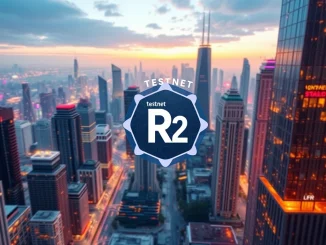
The potential for clear regulatory frameworks governing digital currencies in the United States has long been a hot topic. Now, a prominent voice from the traditional financial sector is weighing in. Anthony Soohoo, the MoneyGram CEO, recently shared his perspective, suggesting that the passage of a comprehensive US Stablecoin Bill could serve as a ‘huge unlock’ for business opportunities.
This statement, reported by financial news aggregator ZeroHedge on X, highlights the growing recognition within established companies that regulatory clarity is not just a compliance issue, but a catalyst for innovation and growth in the realm of digital assets.
Why is Stablecoin Regulation Seen as an ‘Unlock’?
For years, the lack of clear Stablecoin Regulation in the U.S. has been cited as a major hurdle for businesses looking to seriously engage with cryptocurrencies beyond speculative trading. Without a defined legal and operational framework, companies face significant uncertainty regarding everything from consumer protection and anti-money laundering (AML) rules to how these assets will be taxed and integrated into existing financial systems.
A well-crafted US Stablecoin Bill could provide this much-needed certainty. Here’s how it could act as a catalyst:
- Legal Clarity: Defining stablecoins and the rules around their issuance, reserves, and redemption provides a solid legal foundation.
- Increased Trust: Regulatory oversight can build confidence among consumers, businesses, and financial institutions regarding the stability and reliability of stablecoins.
- Integration with Traditional Finance: Clear rules make it easier for banks, payment processors (like MoneyGram), and other financial entities to integrate stablecoins into their services.
- Innovation Pathways: With regulatory guardrails in place, businesses can confidently invest in developing new products and services utilizing stablecoins, fostering the broader crypto business ecosystem.
What Does This Mean for MoneyGram and the Crypto Business Landscape?
MoneyGram, known primarily for its cross-border money transfer services, operates in a market ripe for disruption by digital currencies. Stablecoins, designed to maintain a stable value relative to traditional currencies like the U.S. dollar, are particularly well-suited for payments, remittances, and international transactions.
The MoneyGram CEO‘s view underscores the potential strategic advantage that clear stablecoin rules could offer. Imagine a world where sending money across borders using a regulated, U.S. dollar-pegged stablecoin is as straightforward and compliant as using traditional rails, but potentially faster and cheaper. This could significantly enhance MoneyGram’s offerings and competitive position.
For the wider crypto business sector, regulatory clarity could open doors to:
- Mass adoption of stablecoins for everyday transactions.
- Development of sophisticated decentralized finance (DeFi) applications built on regulated stablecoin foundations.
- Greater participation from large corporations and institutional investors who have been hesitant due to regulatory ambiguity surrounding digital assets.
Navigating the Path to Effective Stablecoin Regulation
While the potential benefits are clear, crafting effective Stablecoin Regulation is complex. Policymakers face the challenge of balancing innovation with necessary safeguards. Key considerations include:
- Reserve Requirements: Ensuring stablecoins are fully backed by safe, liquid assets is crucial for maintaining stability.
- Consumer Protection: Rules are needed to protect users from fraud, mismanagement, and loss of funds.
- AML/CFT Compliance: Integrating stablecoins into existing anti-money laundering and counter-terrorist financing frameworks is essential.
- Interoperability: How will different regulated stablecoins interact?
- State vs. Federal Roles: Determining the appropriate balance between federal and state oversight.
The ongoing debate around the US Stablecoin Bill in Congress reflects these complexities. Different proposals have varying approaches to these issues, and finding consensus is key to unlocking the potential Soohoo describes.
What’s Next for the US Stablecoin Bill?
The legislative process is often slow and subject to political dynamics. However, the increasing focus on Stablecoin Regulation from policymakers and figures like the MoneyGram CEO suggests momentum is building. The industry eagerly awaits a bill that can pass both houses of Congress and be signed into law.
The outcome of this legislative effort will significantly shape the future of digital assets and the crypto business in the United States, potentially paving the way for a new era of financial innovation driven by regulated stablecoins.
Summary: Unlocking the Future with Clear Rules
Anthony Soohoo’s remarks serve as a powerful indicator of the potential upside that regulatory clarity holds for the integration of digital currencies into the mainstream economy. A well-designed US Stablecoin Bill isn’t just about imposing rules; it’s about creating the conditions for growth, trust, and innovation that can benefit established players like MoneyGram and the burgeoning crypto business sector alike. The journey to enacting effective Stablecoin Regulation is ongoing, but the promise of a ‘huge unlock’ keeps the industry and policymakers focused on finding a path forward for these transformative digital assets.



